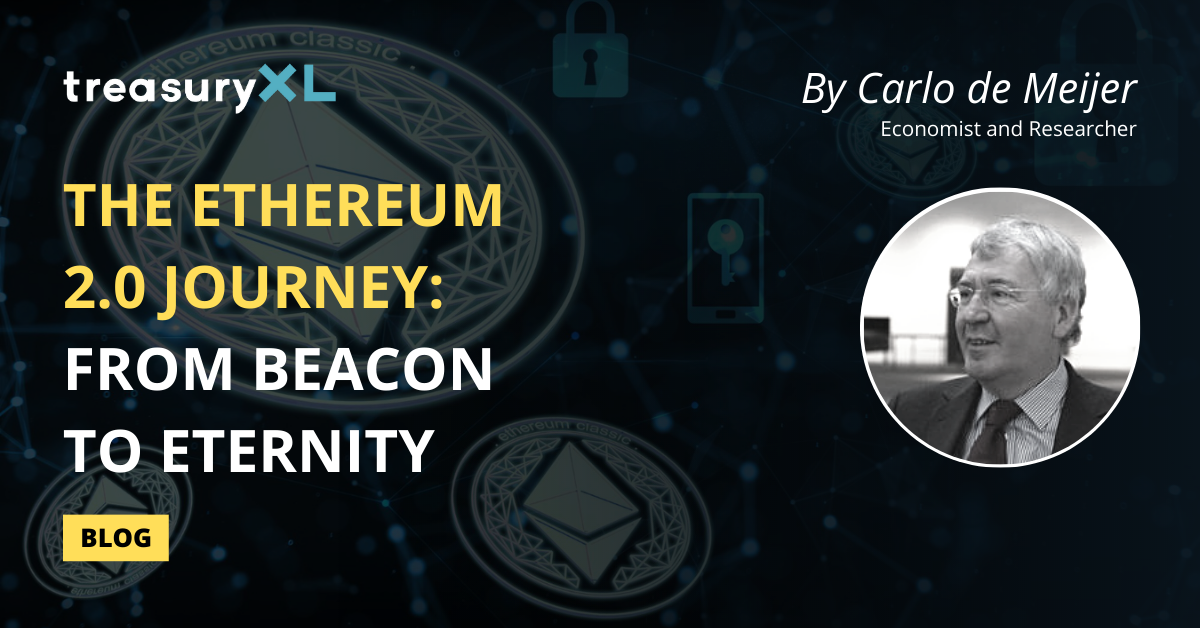Last year September Ethereum blockchain entered a new phase in its Ethereum 2.0 journey. After launched the Beacon Chain in December 2020, a parallel blockchain which acts as consensus engine that runs on proof of stake, The Merge was concluded in September 2022 whereby the Beacon Chain and the Mainnet, the normal Ethereum blockchain, merged into one blockchain thereby switching from Proof of Work to Proof of Stake.
Recently it was announced that a third important step is planned on 10 April: the Shanghai upgrade or hard fork. This upgrade is expected to bring significant improvements to the network, including enhanced scalability, improved security, better support for smart contracts and decentralized applications as well as greatly reducing energy consumption.
In this blog I will take you by the hand in the further Ethereum 2.0 journey towards the final stage: Eternity.
Beacon Chain: start of the Ethereum 2.0 journey
The Ethereum 2.0 journey was kickstarted by the Beacon Chain launch in December 2020, termed Phase 0 of the Ethereum 2.0 roadmap. This phase aimed to introduce and test the proof of stake consensus in the Ethereum context.
The Beacon Chain was a blockchain which acted as a consensus engine of Ethereum 2.0, the part that coordinates the entire system. This upgrade proposed a parallel blockchain which runs on proof of stake, while the Ethereum Mainnet continued to be secured by proof of work.
The Beacon Chain did not process transactions or host the smart contracts. It was intended as the heart of Ethereum 2.0, which would replace the miners in Proof of Work with validators who decide the blocks.
Prior to the Merge, validators began staking 32 ether (ETH) on the Beacon Chain in order to participate in the block validation process. Validators could stake their ethers in smart contracts, and as a reward they got interest. Before validators agreed to participate on the PoS blockchain, they were made aware that their staked ETH and any accrued rewards would remain locked up until a subsequent update to the chain.
The Merge
One of the most anticipated crypto occasions last year was the Ethereum Blockchain’s Merge. On 15 September 2022 the Beacon Chain with its new proof of stake consensus layer and the Mainnet, the normal Ethereum blockchain, merged into one blockchain. The Merge marked a significant step in the Ethereum blockchain’s transition to a proof-of-stake (PoS) consensus mechanism from proof-of-work (PoW).
The Merge represents the formal adoption of the Beacon Chain on the new consensus layer to the original Mainnet execution layer. The Merge will completely cast aside the role of crypto miners, to now assign the ‘validators’ who randomly approve transactions and add blocks to the Ethereum blockchain and earn a small reward, eliminating the need for energy-intensive mining. Instead of competing on speed and energy to generate a hash – it is estimated that Ethereum’s energy consumption got reduced to a whopping 99.95% – validators in PoS systems compete on the amount of ether staked (deposit).
Validators are now responsible for processing the validity of all transactions and proposing blocks. A validator will be chosen at random from a group of individuals who have “staked” (basically, pledged at least 32 Ethereum tokens on the network) their money. The PoS system should ensure the validator nodes are sufficiently incentivized to maintain the network’s security. The more ETH a validator stakes, the more likely they will be selected to “propose” the next block of Ethereum transactions and earn some network rewards.
But in addition to accessing locked up funds, the PoS blockchain has not been fully featured ever since it went live. Even though the blockchain functions properly today, stakers have had to commit to keeping their funds locked in order to keep Ethereum running.
Upcoming upgrades
Ethereum has announced a number of important upgrades on 10 April. Shanghai and Capella are the upcoming Ethereum hard forks names. Ethereum developers have started to refer to the blockchain’s upcoming hard forks – in this case a key upgrade – as (Shanghai + Capella =) “Shapella.”
The Ethereum protocol is made up of two layers: the execution layer and consensus layer. Now, the two layers have different functions that help move the Ethereum blockchain forward. The execution layer is where all smart contracts and protocol rules live. The consensus layer is in charge of making sure that all validators on the network are following those rules.
Technically the Shanghai upgrade is only on the execution side of Ethereum. Capella is the simultaneous upgrade happening on the consensus side. Major changes to the consensus layer include full and partial withdrawals for validators and independent state and block historical accumulators, replacing the original singular historical roots.
Shanghai upgrade
The Shanghai upgrade, also known as hard fork, initially scheduled for March was later postponed by Ethereum developers until 12 April. This upgrade is expected to bring significant improvements to the network, including enhanced scalability, improved security, and better support for smart contracts and decentralized applications. The network upgrade will address staked ether withdrawals and reductions in gas fees for developers.
Some key Ethereum improvement proposals (EIP) on the execution layer include Beacon Chain push withdrawals and warm Coinbase. The Shanghai upgrade will complete Ethereum’s full transition to a proof of stake (PoS) network by finally allowing validators to withdraw their staked Ether from the Beacon Chain to the Ethereum Virtual Machine (the execution layer) via a new “system-level” operation type. The Ethereum Virtual Machine (EVM) is the environment where Ethereum is able to execute smart contracts.
Up till now a total of 16 million ETH (roughly 30 bn dollar) have thus far been “staked” on the Beacon Chain to help secure the network since December 2020.
To prevent instability on the market, validators cannot stake in one go. They may be subject to a daily ETH redemption quota because of the processing constraints on the Ethereum network. They can only stake their saved staking yields immediately. In total less than 60.000 ETH a day will be available for withdrawal.
The warm Coinbase is the name of the software that builders use to receive new tokens on the network. Every new platform transaction must interact with the Coinbase software multiple times. With the introduction of EIP-3651 the Coinbase software will remain warm to begin with, requiring a lower gas fee to access it, instead of needed to ‘warm up’.
Now with the mechanism that will unlock staked ETH, the full operation of a proof-of-stake blockchain will come to life, meaning that stakers can finally have control over their funds and decide what they want to do with their rewards.
Updated roadmap: Further upgrades
The Shanghai upgrade is a major upgrade and transformation of the Ethereum network. It is an essential step on the road to Serenity, which is the final phase of the broader roadmap for Ethereum 2.0.
The Ethereum updated Roadmap paves the way for a number of further upgrades within the coming years. The Merge has set the stage for further scalability upgrades not possible under proof-of-work, bringing Ethereum one step closer to achieving the full scale, security and sustainability. Ethereum 2.0 will thereby introduce several new technologies and protocols, proto-danksharding, and a new virtual machine (VM) called eWASM. There are four major upgrades with interesting names such as Surge, Verge, Purge and Splurge.
The Surge: Proto-danksharding
Developers decided to keep the scope of the Shanghai upgrade relatively small, mainly so that staked ETH withdrawals would be released as soon as possible. As a result, some other big changes to the Ethereum protocol such a proto-danksharding primarily aimed at improving transaction output, were pushed back to the third quarter of 2023.
The initial plan was to implement sharding, splitting up transactions into multiple chains to reduce fees and speed up transactions. But, as sharding has proven difficult to implement and as Layer 2 technologies evolved, the sharding plan was updated to a format that improves the scalability of Layer 2 networks or rollups like Arbitrum and Optimism: the so-called Pro-danksharding also known as EIP-4844.
“[Proto-]danksharding will be the most exciting thing devs will work on in 2023.” Proto-danksharding has “the potential to onboard millions of users and truly provide scalability to Ethereum.” Parithosh Jayanthi, DevOps engineer Ethereum Foundation
The proposed Proto-danksharding (PDS) aims to move all computation to Layer 2 networks (execution layer) and data to be posted on the Ethereum mainnet (data layer). Layer 2 networks are companion systems designed to help a cryptocurrency system handle a larger volume of data. Compared to sidechains, Layer 2 networks or rollups are considered to be the more secure way for Ethereum to scale. Rollups, like sidechains, take the stress off of Ethereum by executing transactions on a separate blockchain.
While danksharding takes the same principle of splitting a network into shards, instead of providing more space for transaction, it is adding a new transaction type to Ethereum, the so-called blob-carrying transaction which can carry an extra piece of data called blob, allowing Ethereum to process more data. Transactions are ‘settled’’ on the rollup chain, bundled, and then ‘posted’ to Ethereum.
Unlike sidechains, rollups borrow their security from the Ethereum mainnet, thereby using fancy cryptography and other methods (like a multi-day dispute period) to allow Ethereum mainnet nodes to confirm that transactions are legitimate.
Once the proto-danksharding and its associated updates are in place, it is expected to be able to at least increase the transaction throughput to 100,000 transactions per second and beyond (on rollups), significantly decreasing the cost of using rollups.
The Verge
Another upgrade is The Verge that reduces the amount of blockchain data that validators have to store for transaction validation purposes.
The verge will therefore introduce a new data structure called “Verkle trees”. This is – a modified version of a Merkle tree that blockchains like Bitcoin typically use. Verkle trees use vector commitments instead of hash functions in Merkle Tree. A Merkle-Tree requires more hashes as the number of child nodes increases, whereas using vector commitments allow the tree to expand without increasing the proof size.
The Verge will also introduce “stateless clients,” which allow users on the network to become validators without having to store extensive amounts of data on their machines. This means validators can run a node with a lower hardware requirement, making it more economical to run a node in the long run.
The Verge aims to simplify the verification of blocks. It has a set of plans which can decrease the hardware requirements of validators. Stateless clients can verify blocks without downloading a local copy of Ethereum’s state, which can boost the storage requirement. These updates are mainly related to zero-knowledge (ZK) technology.
The Purge
The purge aims to reduce the amount of space required on one’s hard disc, simplify the Ethereum protocol over time, and stop needing nodes to keep history using history and state expiration. Similar to Verge, the role of Purge is to minimise memory load on the client side, by reducing outdated excess historical data on the blockchain.
History expiration will instruct nodes to stop serving historical blocks whose age is above a limit and allow nodes to delete these from their local copy of the blockchain. New nodes will follow a different syncing mechanism which will sync the chain from the most recently finalized block instead of the genesis block. Once a node is fully synced, it will not require historical data to validate future blocks.
This doesn’t mean that data would get deleted from the blockchain after some time. Only fewer services in the world would store the complete and full historical data of the Ethereum blockchain. This will also help minimise network congestion, as validators themselves can process each transaction without back-checking the entire blockchain history. The entire history becomes accessible only on demand.
The idea of state expiration is to prune portions of the state that have remained unused for a certain period. The shortened state will be represented by a Verkle tree root that users can use to retrieve the expired state. The expiration techniques can reduce the storage requirements for nodes and ease processing requirements on the client side. This phase also proposes changes to logs, data serialization and EVM operations.
The Splurge
As the name suggests, at this phase, Ethereum 2.0 devices can go on a “development splurge” to include features that are currently considered low priority.
A series of upgrades will combine improvement proposals that don’t exactly fit in with the high priority upgrade phases. This includes a set of miscellaneous updates related to various factors to ensure that the network keeps operating smoothly and that the updates to the protocol in the previous sections do not cause any issues.
It is anticipated that Ethereum 2.0 will especially focus on introducing new features to enable the development of decentralized applications simpler. It will include new capabilities that will make it easier for programmers to comprehend what is happening between their code and the EVM. While the account abstraction aims to reduce from two account types down to one, a contract account. This will allow users to choose arbitrary verification logic, like quantum-resistant signature schemes.
The further road to Serenityf
Serenity, the final stage of the Ethereum 2.0 roadmap, is expected to bring even more significant improvements and enhancements to the network, including the ability to handle millions of transactions per second, support for private transactions, while also reducing energy consumption and improving security and decentralization.
Ethereum 2.0 and Serenity are highly anticipated by the Ethereum community. As the Ethereum blockchain is a house to some of the most widely used cryptocurrency applications, they are expected to play a significant role in the future of decentralized finance (DEFI), non-fungible tokens (NFTs), and other blockchain-based applications and services. It would however still take a number of years until Ethereum 2.0 reaches the final stage of this broader roadmap. By then, the Ethereum network would look very different to what we see today.
Many analysts believe that the Ethereum 2.0 ecosystem that is now being constructed will lead to a system that will attract many more investors. They expect that Ethereum will play an important role especially for investors from the traditional money markets. They not only may benefit from a passive income with low maintenance costs to maintain their positions. What is more important is the fact that they may benefit of complete liquidity now Ether is no longer completely locked in stakes. It is this aspect that many do believe that Ethereum will enter a new area with more traditional institutional investors that wish to buy a stake in on one of the most important smart contract platforms.













